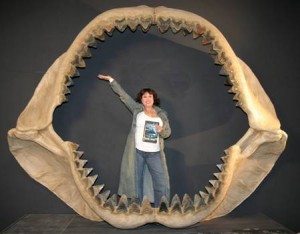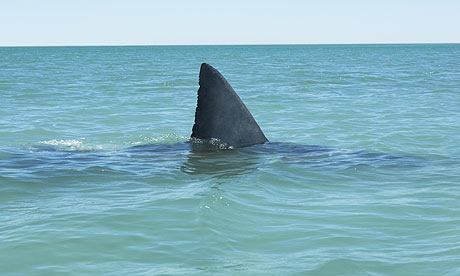A letter was published recently in the Bangkok Post's Postbag about shark fin soup and how the writer was disgusted with the fact that the Bangkok Post had previously mentioned that shark fin soup was available at various restaurants throughout Bangkok.
The writer thought that the Bangkok Post was advocating the sale of shark fin soup and was horrified that it would do such a thing. I confess I never read the article, but I do have very strong feelings on the matter.
Simply put, finning - the act of cutting off a shark's fins for the shark fin soup trade - is appalling. Not only is it barbaric, it is an eco-catastrophe of humongous proportions.
Finning for soup
There are around 50 million sharks killed by humans each year, but that may be a conservative estimate, given the existence of the illegal fishing trade. There may well be many more millions killed, especially for their fins.
When a shark is caught for its fins, it is hauled onto a boat, where its dorsal, pectoral and tail fins are removed. Then it is thrown back into the ocean, often alive, and left to bleed to death, drown or be eaten alive by other fishes. This is wanton brutality.
The worst thing about shark fin soup is that it is happening because of a status issue. Many Chinese eat shark fin soup as a sign of elitism, and it is often served at special occasions like weddings, birthday parties and business dinners. And the irony of it all is that it has no real taste!
The fin is cooked until it breaks down into its cartilaginous threads, a little like transparent noodles. It has flavour only because it is cooked in beef or vegetable stock.
Some people argue that a shark fin has medicinal value, but no scientist would ever confirm this. As is always the case with barbaric wildlife abuses, when the buying stops, the killing can too.
Evolutionary peak
Sharks and rays represent evolution at its finest. They are a branch of fish known as cartilaginous fish, as their support system is composed of cartilage, not bones, unlike the bony fish you may be familiar with.
There are over 360 known species of shark and they have been around in their modern form for about 100 million years. Based on fossil evidence, sharks and their ancestors have been on earth for around 420 million years.
All sharks are carnivorous, with most being streamlined and sleek for quick swimming when hunting. Although many people have a fear of sharks, arguably due to the Jaws movies, the vast majority of sharks are not harmful to humans.
The largest shark species is the whale shark, measuring up to an incredible 12m in length, making it the largest fish in the ocean. Yet despite its size, it eats tiny krill and other small invertebrates. The second-largest shark, the basking shark, is also harmless and is a filter feeder like the whale shark.
The largest predatory shark is the great white shark. It can grow to over 6m and has been known to kill people, but surprisingly, the number of deaths is much less than you would imagine. Other sharks that have been known to prey on humans include the oceanic whitetip shark, the tiger shark and the bull shark.
Despite these apparently ferocious animals living in our seas, oceans and, in the case of bull sharks, even rivers, there are only about four to five human deaths per year. Compare that to the over 50 million shark deaths caused by humans, and then ask yourselves who the real predators are.
Odd adaptations
With over 360 species, there is still a lot to be discovered about sharks. Some strange shark species include the dwarf lanternshark, which is the smallest known species, with adults rarely exceeding 20cm in length!
There is also the very odd-looking wobbegong shark, which lies motionless on the bottom of the sea, waiting for any passing fish to strike at. Although this doesn't quite fit the streamlined approach common to many sharks, it is still an efficient predator.
The 7m Greenland shark is a huge deep-ocean monster. Although not harmful to humans and very sluggish, it does feed on large mammals. Strangely, in all the Greenland shark adults, there is a parasitic copepod, a small crustacean, which attaches itself to the cornea of the eyes of the shark and feeds on the eye tissue! This makes the sharks nearly blind, yet they all have them!
A strange adaptation of sharks is that they don't have a swim bladder. This means that if they stop swimming they will sink! Many also have to constantly swim in order to obtain oxygen through their gills. Many beaches have shark nets to prevent sharks from getting to swimmers, and sharks that get caught in them often drown. It seems odd that you can drown a fish, but, sadly, it is true.
The skin of sharks is covered with teeth-like structures. If you rub a shark from head to tail, it will feel smooth, but if you stroke its skin in the opposite direction the skin will feel very rough and can even cut your hand! These dermal denticles reduce water resistance while the shark is swimming.
Shark's teeth constantly replace themselves throughout the life of the animal. They have many layers of teeth that rotate to the edge of their mouth, kind of like a conveyor belt. When the teeth get old or become worn out, the new rows of teeth behind simply roll forward and take their place. Therefore, sharks can have thousands of teeth in their lifetime, all of which are shaped and adapted to the kinds of food the shark eats.
Sharks have a sixth sense and are sensitive to electrical impulses. They have electroreceptor organs in their heads, allowing them to detect the movements of fish.
The most stunning example of an adaptation in the animal kingdom is arguably the hammerhead shark. It is the most sensitive animal in the world to electrical impulses. Its sensors are located all across the front of its oddly shaped head. It uses them to sense the impulses given off by a struggling fish.
The most bizarre feature of sharks is that if you turn them upside down, they go into a state of torpor, a kind of sleep!
Shark researchers often catch sharks and turn them upside down so that they can record information relating to the creatures without having to drug them. There are even people who try to do this with great whites, but it is not an easy task!
Dave Canavan has an MSc in Behavioural Ecology and is the Head of Secondary at Garden International School. Dave is fascinated by science and loves animals, especially the dangerous kind! You may contact Dave at davidc@gardenbangkok.com .
- By: DAVID CANAVAN
- Published: 16/06/2009 at 12:00 AM
- Newspaper section: Learningpost










